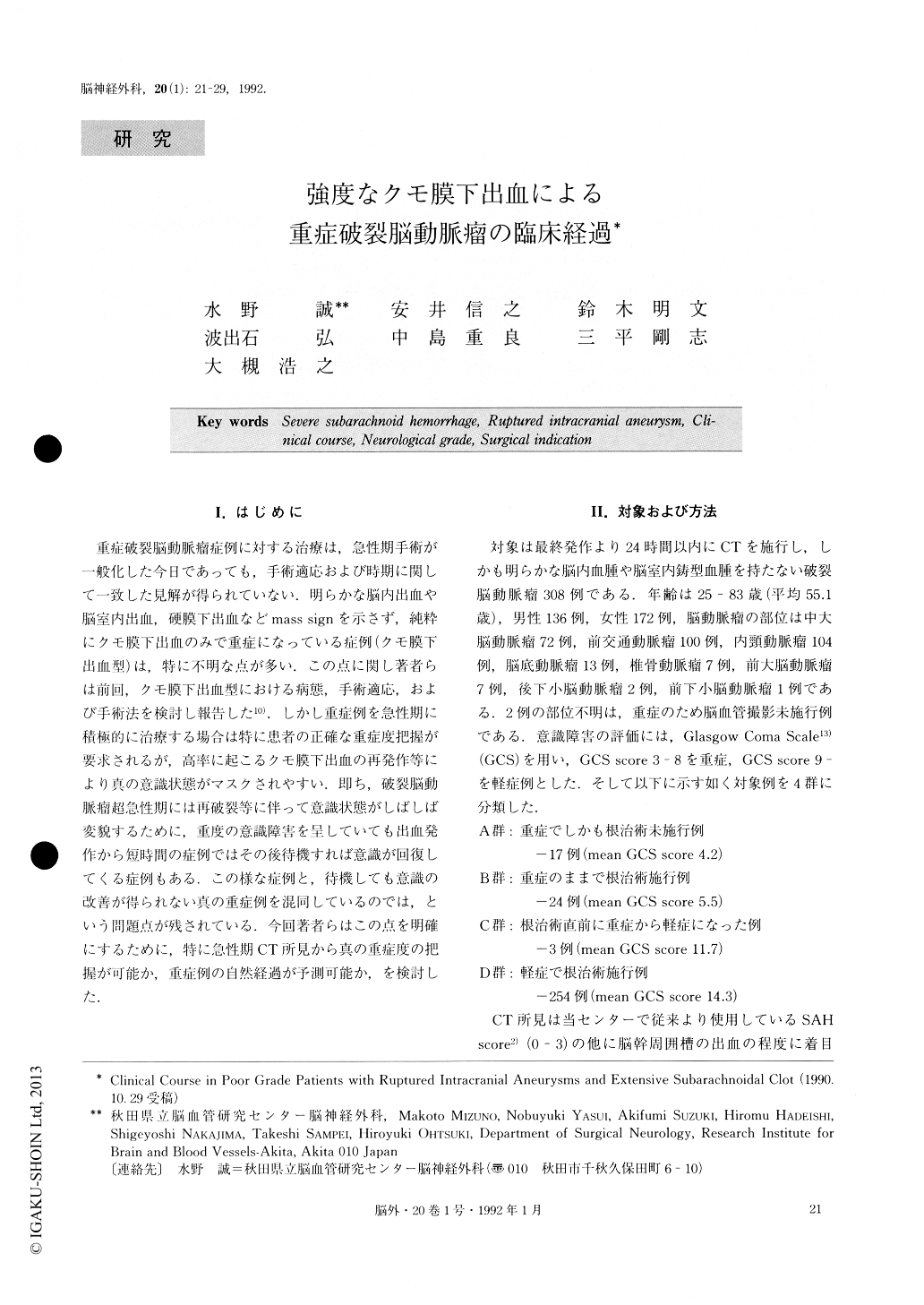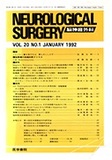Japanese
English
- 有料閲覧
- Abstract 文献概要
- 1ページ目 Look Inside
I.はじめに
重症破裂脳動脈瘤症例に対する治療は,急性期手術が一般化した今日であっても,手術適応および時期に関して一致した見解が得られていない.明らかな脳内出血や脳室内出血,硬膜下出血などmass signを示さず,純粋にクモ膜下出血のみで重症になっている症例(クモ膜下出血型)は,特に不明な点が多い.この点に関し著者らは前回,クモ膜下出血型における病態,手術適応,および手術法を検討し報告した10).しかし重症例を急性期に積極的に治療する場合は特に患者の正確な重症度把握が要求されるが,高率に起こるクモ膜下出血の再発作等により真の意識状態がマスクされやすい.即ち,破裂脳動脈瘤超急性期には再破裂等に伴って意識状態がしばしば変貌するために,重度の意識障害を呈していても出血発作から短時間の症例ではその後待機すれば意識が回復してくる症例もある.この様な症例と,待機しても意識の改善が得られない真の重症例を混同しているのでは,という問題点が残されている.今回著者らはこの点を明確にするために,特に急性期CT所見から真の重症度の把握が可能か,重症例の自然経過が予測可能か,を検討した.
Three hundred and eight cases with ruptured in-tracranial aneurysms and variable amounts of subarach-noidal clot were evaluated clinically with special emph-asis on the natural course of poor grade patients. Cli-nical severity was classified according to the Glasgow Coma Scale (GCS); severe cases (score 3 - 8) and mild cases (score 9 - 15). Patients were further divided into four groups based on the preoperative clinical course, and on whether radical surgery was performed or not. Group A, severe cases without radical surgery (17 patients, mean GCS score 4.2); group B, severe cases (which had undergone) radical surgery (24 cases, mean GCS score 5.5); group C, patients considered as severe cases on admission that had improved to mild cases before radical surgery (3 patients, mean GCS score 11.7); group D, mild cases which had undergone radical surgery (254 cases, mean GCS score 14.3). CT findings after their last bleeding episode were evaluated in each group using subarachnoid hemorrhage (SAH) score from “0”-“3” according to the severity of SAH. In addition, the SAH-B (brainstem) score (“0”-“9”) was also evaluated. In this score, the amount of SAH in each perimesencephalic cistern (a. prepontine or in-terpeduncular cistern, b. ambient cistern, c. quad-rigeminal cistern) was considered with a possible score of “0”-“3” for each cistern. (No patient had a concur-rent intracerebral or intraventricular hematoma causing a mass effect on CT scan).
All cases in group A died except one patient that re-mained in a vegetative state. All of them had severe subarachnoidal clot (mean SAH score 2.9, SAH-B score 8.2). In group B, in patients with same scores (mean SAH score 2.8, mean SAH-B score 7.3), the outcome was as follows : 6 patients (33.3%) had full re-covery or were capable of self-management, 6 patients (33.3%) were partially or fully dependent, and 12 pa-tients (50%) were either in vegetative state or died. Pa-tients in groups C and D with good outcome had signi-ficantly less amount of SAH, especially in the perimesencephalic cistern (group C - mean SAH score 2.3, mean SAH-B score 3.7, groupD-mean SAH score 1.9, mean SAH-B score 3.3).
It is concluded that duration and level of uncon-sciousness in the cases of SAH without concurrent hematoma causing mass effect, has a good correlationwith the severity of SAH in the perimesencephalic cis-terns. The clinical condition of severe cases with exten-sive SAH especially in the perimesencephalic cisterns, cannot be expected to improve after intentionally de-layed operation, but radical surgery on an emergency basis should be performed if brainstem function is de-monstrated.

Copyright © 1992, Igaku-Shoin Ltd. All rights reserved.


